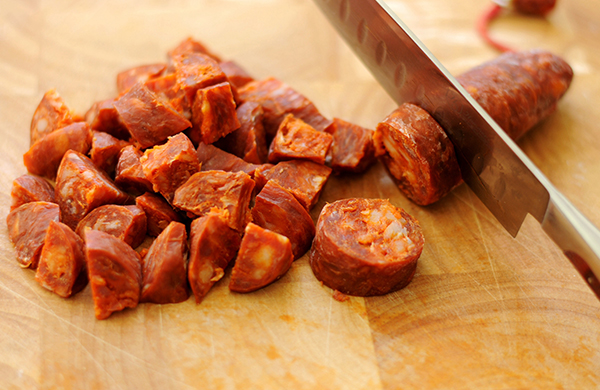
If you’ve visited a Spanish or Mexican restaurant within the last few years, it’s likely you’ve seen chorizo somewhere on the menu. It’s even offered at fast-casual places like Chipotle. Despite the sausage becoming more common in American cuisine, you might still be wondering: what is chorizo, exactly? What gives it that distinct, deep-red color? Is it spicy?
To find out, I turned to Vincent Delagrange, head butcher and sous chef at Cleveland’s Urban Farmer Steakhouse (and older brother to yours truly).
What is chorizo sausage?
First of all: yep, it’s a sausage. There are two types you’re likely to see, though. “There’s Spanish and Mexican chorizo—the differences are generally pretty slight in [terms of] flavor,” Vincent says. “Spanish chorizo is a dried sausage … Mexican is the kind you find in the grocery store, refrigerated and raw.”
What’s in it?

Along with pork and garlic, there’s nothing in it that you wouldn’t also find in your spice rack. According to Vincent, Spanish chorizo usually includes paprika—smoked paprika is particularly popular—garlic, and oregano, while the Mexican variety incorporates traditional Mexican spices, such as cumin, chili powder, and even cinnamon.
Is it supposed to be spicy?
“Traditionally, chorizo is not a spicy—in terms of Scoville—sausage at all,” Vincent says, referencing the units used to measure the heat of chili peppers. “There’s nothing in it that would provide a whole lot of heat other than paprika or a chili powder.”
Vincent does note, however, that chorizo sausage should have a lot of flavor coming from its spices. “It should be a heavily spiced sausage...you should be tasting sweet pork and roasted flavors from the spices.”

Is there another food that tastes similar?
“Flavor-profile wise, it’s going to taste similar to a Betty Crocker chili recipe,” Vincent says, before adding that chorizo’s taste can’t really draw an identical comparison to anything else. “Chorizo is kind of its own beast.”
How is it served?

Since Spanish chorizo is a dried sausage, it’s usually served on its own as part of a charcuterie platter or appetizer. “Something like chorizo with a grilled artichoke heart would be a nice pair,” Vincent says.
Mexican chorizo, on the other hand, varies a little more in how it’s served. “Traditionally, it’s ground up and used for enchiladas, tacos—a lot of times, you’ll see it on nachos,” Vincent adds. While chorizo is found in Mexican staples, according to Vincent, it also makes a great pairing with an unusual partner: seafood. “It’s good with seafood because things like mussels or clams are salty and almost fruity, and [pairing that] with the heavy, roasty chorizo is a nice contrast of flavors.”
Why should people try it?
Aside from it being delicious? Because it’ll taste more familiar to picky eaters or those looking to expand their culinary horizon than they might expect. “If you’re looking to get into a more exotic cuisine, Mexican food is a pretty safe way to go,” Vincent says. “It’s almost mainstream American; there’s going to be a lot of similarities to almost anything you’ve tasted.”

